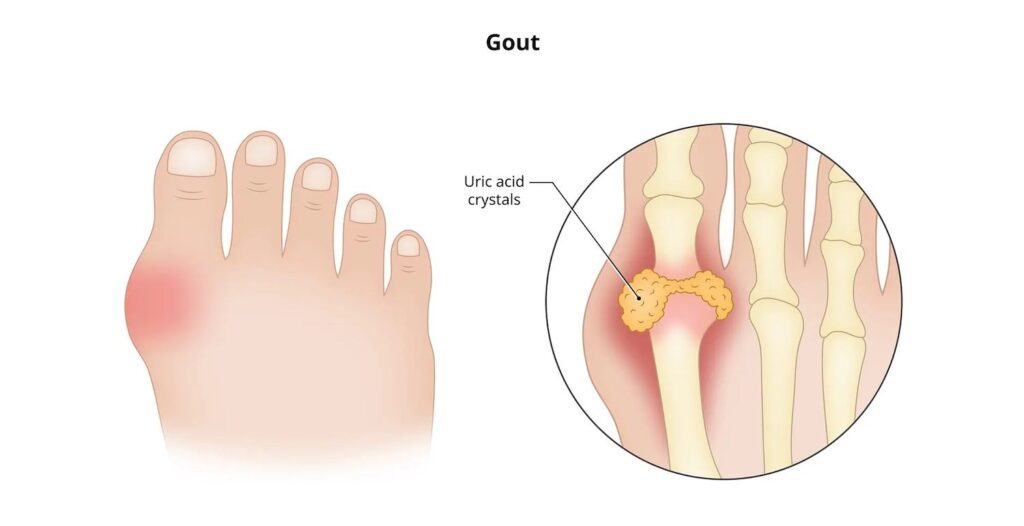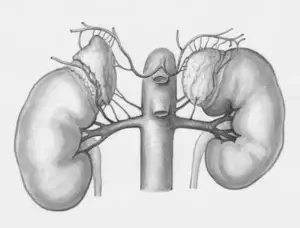
What is Gout?
Gout is caused by an accumulation of uric acid crystals in the joints, leading to inflammation, swelling, and intense pain. While uric acid is a natural byproduct of breaking down purines (substances found in various foods and within our own bodies), excessive levels in the blood can lead to crystal formation. This often happens in the joint of the big toe but can also occur in the ankles, knees, wrists, and fingers. Because gout is both chronic and episodic, it requires ongoing awareness and management.

The Primary Causes of Gout Disease
Many factors contribute to the development of gout, some of which are directly influenced by lifestyle choices, while others are beyond one’s control. Let’s dive deeper into these key causes:
- High Purine Diet
Diet plays a significant role in the causes of gout disease. High-purine foods such as red meat, organ meats, shellfish, and some types of alcohol (particularly beer) contribute to increased uric acid production. While a healthy diet usually balances purine breakdown, a consistent intake of these foods may overwhelm the body’s ability to manage uric acid levels, leading to painful gout flare-ups. - Genetics and Family History
Genetics play a critical role in determining one’s risk for gout. If close relatives have experienced gout, there’s a higher likelihood of developing the condition due to inherited tendencies in how the body processes uric acid. Although genetics alone isn’t one of the modifiable causes of gout disease, knowing your family history can help you take proactive steps to manage risk factors within your control. - Obesity and Metabolic Syndrome
Excess body weight, particularly around the abdomen, is a major factor among the causes of gout disease. Being overweight leads to higher uric acid levels, putting added pressure on joints and increasing the likelihood of gout. Obesity also heightens the risk of metabolic syndrome, which includes insulin resistance and hypertension, both of which increase uric acid levels. Losing even a small percentage of body weight can have a positive impact on managing gout symptoms. - Medical Conditions and Certain Medications
Several chronic conditions, such as high blood pressure, type 2 diabetes, and kidney disease, are associated with high uric acid levels. Impaired kidney function, in particular, can exacerbate the causes of gout disease, as the kidneys play a vital role in filtering uric acid from the blood. Additionally, medications like diuretics (used to treat hypertension) and low-dose aspirin can impede the body’s ability to excrete uric acid effectively. - Dehydration and Low Fluid Intake
Dehydration can significantly contribute to gout. Without adequate hydration, the kidneys are less efficient at flushing out excess uric acid, leading to its buildup in the bloodstream and, eventually, in the joints. Staying hydrated is a simple yet powerful way to mitigate one of the lesser-discussed causes of gout disease, especially for older adults or those with an active lifestyle. - Increased Age and Gender-Based Risks
Although gout can affect people of all ages, it’s most commonly diagnosed in men over 30 and women after menopause. Men typically have higher baseline uric acid levels, which partly explains their higher risk. For women, the risk of gout increases post-menopause, as estrogen, which helps maintain lower uric acid levels, declines.

Recognizing Gout Symptoms
Identifying and understanding gout symptoms is crucial for early intervention and effective management. Key symptoms include:
- Sudden and Severe Joint Pain
Gout is infamous for its sudden attacks of intense pain, often occurring in the middle of the night. This pain usually peaks within 24 hours, making even the slightest pressure on the joint unbearable. While the big toe is the most commonly affected area, gout symptoms can also appear in the knees, wrists, and elbows. - Swelling, Redness, and Warmth in the Affected Joint
Inflammation caused by uric acid crystals makes the affected joint swollen, red, and warm to the touch. This is one of the classic gout symptoms and can be confused with other inflammatory conditions, which is why accurate diagnosis by a healthcare provider is essential. - Prolonged Joint Discomfort
Following an acute gout attack, residual discomfort can linger for days or even weeks, especially without proper treatment. This prolonged soreness is a classic example of ongoing gout symptoms and serves as a reminder to adopt preventative measures.
Preventive Strategies to Address the Causes of Gout Disease
While some causes of gout disease, such as genetics, cannot be changed, other factors are within your control. Here are some practical strategies for reducing your risk of gout flare-ups:
- Adopt a Low-Purine Diet
Limiting purine-rich foods and focusing on a balanced diet can help keep uric acid levels in check. Increase your intake of vegetables, low-fat dairy products, and whole grains, and aim for lean proteins like chicken or fish in moderation. Maintaining a gout-friendly diet is one of the most effective lifestyle changes you can make to prevent the causes of gout disease from manifesting. - Maintain a Healthy Weight
Regular physical activity and weight management play crucial roles in reducing gout risk. Exercise not only aids in weight loss but also improves circulation, which can help lower uric acid levels over time. Incorporating low-impact exercises such as walking, swimming, or cycling can make a positive difference without adding pressure to the joints. - Stay Hydrated
Drinking enough water is essential to support kidney function and prevent uric acid buildup. Aim for 8-10 glasses of water daily, or more if you live in a hot climate or are particularly active. Proper hydration can significantly reduce the frequency and severity of gout symptoms. - Monitor Medication and Medical Conditions
If you’re taking medications that may increase uric acid levels, consult your healthcare provider about possible alternatives. Additionally, managing chronic conditions like hypertension, diabetes, and kidney disease with the guidance of your doctor can help reduce your risk. - Limit Alcohol and Sugary Beverages
Alcohol, especially beer, is high in purines and can elevate uric acid levels. Likewise, sugary beverages and foods contribute to metabolic issues that can exacerbate gout symptoms. By limiting alcohol and added sugars, you help control one of the primary dietary causes of gout disease.
Conclusion
Understanding the causes of gout disease and being able to recognize gout symptoms early on are foundational to effective management. By being mindful of factors like diet, hydration, weight, and family history, you can take proactive steps to mitigate gout risk. Gout is a condition that requires ongoing awareness, but with the right lifestyle choices, many individuals find they can significantly reduce the frequency and intensity of flare-ups. Consult with a healthcare provider for personalized guidance on managing gout, as each individual’s situation and risk factors may vary.

